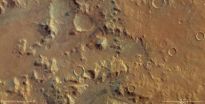Great differences between EU Member States in how well transport systems cope with weather phenomena
2012-11-01
(Press-News.org) This is the first study in the world to evaluate the risks posed to transport by weather phenomena on a country-specific and mode-specific basis. Among the EU Member States, Poland has the highest risk level indicator. The highest-risk regions are in the countries of Eastern Europe and in mountainous areas. Low-risk countries include Ireland, Austria, Luxembourg and the Nordic countries.
The risk-level evaluation was conducted using a risk indicator designed by VTT scientists. The calculations were performed on substantial datasets and involved estimating the probability of phenomena such as heavy rain, floods, landslides, storms and heat waves based on long-term weather statistics. The weather data for the study were supplied by the Finnish Meteorological Institute. The risk indicator also incorporated country-specific data on traffic density, population density, the quality level of transport systems and the economic resources available.
"This is an internationally unique study, because risk levels have never before been determined on a country-specific basis. We found considerable differences in risk levels between countries and regions. In the Nordic countries, Ireland, Austria and Luxembourg, transport systems cope with extreme weather phenomena considerably better than in the EU Member States on average. A number of factors contribute to these low risk levels: a strong economy, low traffic densities and a transport infrastructure that is in good condition and runs smoothly", explains Principal Scientist Pekka Leviäkangas from VTT. "Transport systems face significant risks from extreme weather phenomena in all EU Member States, and it is vital to be able to manage these risks in order to ensure the smooth and safe flow of traffic and thereby the continued functioning of society at large." Cyprus and Malta are also low-risk countries.
Significant differences between countries
The study involved evaluating the risk levels associated with extreme weather phenomena in transport as regards accidents, delays and infrastructure. The cost to transport caused by extreme weather phenomena in the EU Member States is estimated at EUR 15 billion per year at the very least. The majority of this is due to road accidents and delays to transport of goods. Heavy rain and floods cause the most disruption. Heat waves are a significant adverse phenomenon in southern Europe. In the Nordic countries and in mountainous areas, traffic flow may be compromised by snow, ice and frost. Mountainous areas are also prone to landslides
Poland emerged as the country with the highest individual risk indicator. The risk level is also quite high in Italy, Romania and Hungary. Considered by region, the highest risk levels are found in Eastern European countries and in mountainous areas. "Poland has high volumes of traffic and large harbours, and the country's transport systems are in poorer shape than for most parts of the EU. Also, the country experiences a comparatively high incidence of extreme weather phenomena. A problem at a transport hub, such as a port, has extensive knock-on effects on road and rail transport. Poland also has a fairly high population density, and its economy is at the lower end of the scale within the EU," says Leviäkangas. "That is why the risk level there is high."
"Bad weather increases the probability of road accidents. One should always take account of the weather when planning travel, where possible," says Leviäkangas.
"Transport infrastructure can be improved through careful planning that takes better account of weather phenomena. The climate is warming up, and there are weak signals indicating that extreme weather phenomena are on the increase," adds Leviäkangas. "Much greater attention should be paid to the maintenance and upkeep of the transport infrastructure, particularly in urban areas. Drainage systems, for instance, should be functioning as designed, and they should be regularly serviced - sometimes even small things can matter. The appropriate preparation can save a lot in costs in the long term."
###
The principal provider of funds for the project 'Extreme weather impacts on European networks of transport' (EWENT) was the Seventh Framework Programme of the European Commission. In addition to VTT, the research consortium included the Finnish Meteorological Institute, Foreca Consulting Ltd, the Norwegian Institute of Transport Economics, the German Aerospace Centre DLR, the Austrian inland-waterway transport development company Via Donau, the Meteorological Institute of Cyprus, the European Severe Storms Laboratory (ESSL) and the World Meteorological Organisation (WMO).
Project website: http://ewent.vtt.fi/ VTT publication of the report: http://www.vtt.fi/inf/pdf/technology/2012/T43.pdf
ELSE PRESS RELEASES FROM THIS DATE:
Gen X overtaking baby boomers on obesity
2012-11-01
New research from the University of Adelaide shows that Australia's Generation X is already on the path to becoming more obese than their baby boomer predecessors.
Studies show that boomers currently have the highest level of obesity of any age group in Australia. However, new research by University of Adelaide PhD student Rhiannon Pilkington has revealed some alarming statistics. As part of her research, she has compared obesity levels between the two generations at equivalent ages.
Using data from the National Health Survey, Ms Pilkington compared Generation X in ...
UK butterfly populations threatened by extreme drought and landscape fragmentation
2012-11-01
A new study has found that the sensitivity and recovery of UK butterfly populations to extreme drought is affected by the overall area and degree of fragmentation of key habitat types in the landscape.
The analysis, published this week in the scientific journal Ecography, used data on the Ringlet butterfly collected from 79 UK Butterfly Monitoring Scheme sites between 1990 and 1999, a period which spanned a severe drought event in 1995.
The study was led by Dr Tom Oliver from the NERC Centre for Ecology & Hydrology (CEH) in collaboration with colleagues from CEH and ...
Inflammation and cognition in schizophrenia
2012-11-01
Philadelphia, PA, November 1, 2012 – There are a growing number of clues that immune and inflammatory mechanisms are important for the biology of schizophrenia. In a new study in Biological Psychiatry, Dr. Mar Fatjó-Vilas and colleagues explored the impact of the interleukin-1β gene (IL1β) on brain function alterations associated with schizophrenia.
Fatjó-Vilas said that "this study is a contribution to the relatively new field of 'functional imaging genetics' which appears to be potentially powerful for the study of schizophrenia, where genetic factors are ...
Bulletin: German nuclear exit delivers economic, environmental benefits
2012-11-01
Following the accident at the Fukushima Daiichi Nuclear Power Station in 2011, the German government took the nation's eight oldest reactors offline immediately and passed legislation that will close the last nuclear power plant by 2022. This nuclear phase-out had overwhelming political support in Germany. Elsewhere, many saw it as "panic politics," and the online business magazine Forbes.com went as far as to ask, in a headline, whether the decision was "Insane -- or Just Plain Stupid."
But a special issue of the Bulletin of the Atomic Scientists, published by SAGE, ...
Sleep problems cost billions
2012-11-01
If you can't sleep at night, you're not alone. Around ten per cent of the population suffer from insomnia, where you have trouble falling asleep, wake up frequently at night, and still feel tired when the morning comes.
– When you feel tired and indisposed, your performance at work suffers, says Børge Sivertsen, professor at UiB's Department of Clinical Psychology and senior researcher at the Norwegian Institute of Public Health.
Sleep apnoea is a more severe problem, affecting four to five per cent of the population. Sufferers can stop breathing for up to 40 seconds ...
Nereidum Montes helps unlock Mars' glacial past
2012-11-01
On 6 June, the high-resolution stereo camera on ESA's Mars Express revisited the Argyre basin as featured in our October release, but this time aiming at Nereidum Montes, some 380 km northeast of Hooke crater.
The stunning rugged terrain of Nereidum Montes marks the far northern extent of Argyre, one of the largest impact basins on Mars.
Nereidum Montes stretches almost 1150 km and was named by the noted Greek astronomer Eugène Michel Antoniadi (1870).
Based on his extensive observations of Mars, Antoniadi famously concluded that the 'canals' on Mars reported by Percival ...
African American women with HIV/HCV less likely to die from liver disease
2012-11-01
A new study shows that African American women coinfected with human immunodeficiency virus (HIV) and hepatitis C virus (HCV) are less likely to die from liver disease than Caucasian or Hispanic women. Findings in the November issue of Hepatology, a journal published by Wiley on behalf of the American Association for the Study of Liver Diseases, indicate that lower liver-related mortality in African American women was independent of other causes of death.
Medical evidence reports that nearly five million Americans are infected with HCV, with 80% having active virus in ...
Scientists create 'endless supply' of myelin-forming cells
2012-11-01
In a new study appearing this month in the Journal of Neuroscience, researchers have unlocked the complex cellular mechanics that instruct specific brain cells to continue to divide. This discovery overcomes a significant technical hurdle to potential human stem cell therapies; ensuring that an abundant supply of cells is available to study and ultimately treat people with diseases.
"One of the major factors that will determine the viability of stem cell therapies is access to a safe and reliable supply of cells," said University of Rochester Medical Center (URMC) ...
Computational medicine enhances way doctors detect, treat disease
2012-11-01
Computational medicine, a fast-growing method of using computer models and sophisticated software to figure out how disease develops -- and how to thwart it -- has begun to leap off the drawing board and land in the hands of doctors who treat patients for heart ailments, cancer and other illnesses. Using digital tools, researchers have begun to use experimental and clinical data to build models that can unravel complex medical mysteries.
These are some of the conclusions of a new review of the field published in the Oct. 31 issue of the journal Science Translational Medicine. ...
New technique enables high-sensitivity view of cellular functions
2012-11-01
Troy, N.Y. – Researchers at Rensselaer Polytechnic Institute have developed an ultrasensitive method for detecting sugar molecules – or glycans – coming from living organisms, a breakthrough that will make possible a more detailed understanding of cellular functions than either genetic or proteomic (the study of proteins) information can provide. The researchers hope the new technique will revolutionize the study of glycans, which has been hampered by an inability to easily detect and identify minute quantities of these molecules.
"The glycome is richer in information ...


